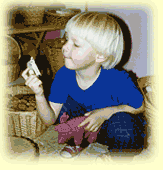KINDERGARTEN
When creating a Steiner inspired kindergarten at home, there are several things to remember.

THE ENVIRONMENT
If at all possible it is a good idea to have a completely seperate room for your kindergarten. The reason for this is because it makes it easier to create the right 'atmosphere' for your child, away from distractions like the computer, TV and video games. If it is totally impossible for you to have a separate room, then utilise your living room, draping softly coloured silks over the TV etc., to hide them and 'soften' the room.
Whatever area you eventually decide upon for your kindergarten must be warm (both in terms of temperature and visually). In a Steiner kindergarten, the walls are usually painted a soft, peachy-pink, you can do this if you want but if you are on a limited budget and watching the pennies, just keep whatever colour you already have. Next, have simple, open shelving so that all toys, books, crayons, paints etc can be placed on them within easy reach of your child. Shells, pinecones, pieces of wood, silks etc can all be placed into natural wicker baskets. The table and chairs you select for your child should also be wood if at all possible. Avoid putting posters and pictures on the wall - keep them plain until you can cover them with your child's beautiful watercolour paintings!
WHAT DOES THE KINDERGARTEN CHILD DO ALL DAY?
Homeschooling your child under the age of 6 should include no formal academics. Certainly, introduce your child to numbers and letters, but do it through nursery rhymes, counting games, nature stories and fairy tales. Your main aim at this stage is to provide your child with environment where they can BE a child. Children of this age learn through imitation, so the best thing you can do is to go about your daily work and allow your child to be with you and watch and, if at all possible, help you. If you're sweeping the floor, give your child a little dustpan and brush and let him/her help, likewise with dusting furniture or sorting laundry. Baking is one of the activities which takes place in a Steiner kindergarten and you should aim to have at least one baking session a week. Bread is always good because it gives your child the chance to really help you by kneading the dough and maybe shaping the dough into bread rolls. A child will always enjoy eating something he has helped bake!
Other activities which you should include for your child are:
COLOURING - with beeswax crayons
WATERCOLOUR PAINTING - the usual method in a Steiner school is wet-on-wet painting which is where the paper is wetted with clear water and then the child paints, allowing the colours to slightly run into each other. Your child will love to see the way two colours mix to form another colour.
BEESWAX MODELLING - natural modelling beeswax has the most beautiful smell when warmed. I have found it is best to put it into the microwave for a minute or so on full power to soften it.
STORIES - You should read to your child daily, nature stories and fairy tales. Many Steiner kindergartens read Grimms Fairy Tales, many people find these stories a little to 'gorey' in places, so it is entirely your choice as to whether you include them or not.
HANDCRAFTS - such as fingerknitting, even the youngest child can learn how to do this as it is very simple.
SEASONAL TABLE - Have a table set aside to create a nature table. This table is covered with cloths in colours of the season (ie orange, brown and gold for Autumn, silver and white for winter etc) and then decorated with paintings your child has produced, seasonal gnomes and fairies,nature walk 'finds' and seasonal items your child has made in handwork. I think I nice way of doing this is to set the table up at the beginning of a new season with just the cloths spread over it and then gradually add items to it over the season.
CIRCLE TIME - Usually, the children in the kindergarten will sit together in a circle on the floor and join together in counting games, singing or puppetry. Even with just one or two children, you can still do this and it is a nice way of ending your kindergarten 'day'.
RHYTHM
The single most important thing to remember when your child is at this age is rhythm. Children feel most secure and happy when they know what to expect, this is why it is important, if at all possible, to stick to regular mealtimes and bedtimes. Therefore, draw up a simple timetable of your daily activities and try to stick to it. It may be difficult at first, but after a time your child will begin to anticipate with pleasure a forthcoming activity. The timetable we are currently using is as follows:
OUR CURRENT DAILY TIMETABLE
A.M
The mornings (following breakfast) are given over to tidying the house and preparing our kindergarten room for the afternoons activities. Our daughter also tends to watch TV in the mornings for a little while - many families who use the Steiner method of education actually do dispense with TV altogether and of course you can do this if you wish, but we cannot!
P.M
Directly after lunch we have some sort of 'organised' activity, e.g. -
Monday - colouring with beeswax crayons
Tuesday - baking
Wednesday - handi-crafts
Thursday - beeswax modelling
Friday - watercolour painting
After our activity we clear up Rosie always helps with this. We then move on to story time - we sit together comfortably and I read the story to her, sometimes we'll use finger puppets to act out the story at the same time. We finish our afternoon with circle time (see above for details).